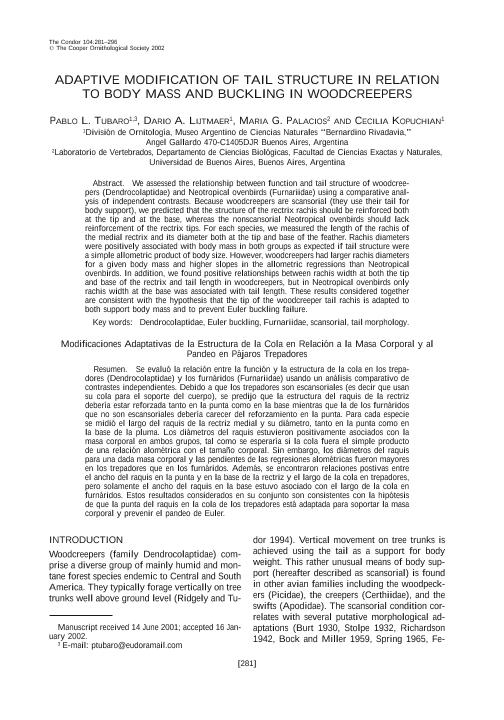Mostrar el registro sencillo del ítem
dc.contributor.author
Tubaro, Pablo Luis

dc.contributor.author
Lijtmaer, Dario Alejandro

dc.contributor.author
Palacios, María Gabriela

dc.contributor.author
Kopuchian, Cecilia

dc.date.available
2021-07-20T12:36:38Z
dc.date.issued
2002-05
dc.identifier.citation
Tubaro, Pablo Luis; Lijtmaer, Dario Alejandro; Palacios, María Gabriela; Kopuchian, Cecilia; Adaptive modification of tail structure in relation to body mass and buckling in woodcreepers; Cooper Ornithological Society; The Condor; 104; 2; 5-2002; 281-296
dc.identifier.issn
0010-5422
dc.identifier.uri
http://hdl.handle.net/11336/136482
dc.description.abstract
We assessed the relationship between function and tail structure of woodcreepers (Dendrocolaptidae) and Neotropical ovenbirds (Furnariidae) using a comparative analysis of independent contrasts. Because woodcreepers are scansorial (they use their tail for body support), we predicted that the structure of the rectrix rachis should be reinforced both at the tip and at the base, whereas the nonscansorial Neotropical ovenbirds should lack reinforcement of the rectrix tips. For each species, we measured the length of the rachis of the medial rectrix and its diameter both at the tip and base of the feather. Rachis diameters were positively associated with body mass in both groups as expected if tail structure were a simple allometric product of body size. However, woodcreepers had larger rachis diameters for a given body mass and higher slopes in the allometric regressions than Neotropical ovenbirds. In addition, we found positive relationships between rachis width at both the tip and base of the rectrix and tail length in woodcreepers, but in Neotropical ovenbirds only rachis width at the base was associated with tail length. These results considered together are consistent with the hypothesis that the tip of the woodcreeper tail rachis is adapted to both support body mass and to prevent Euler buckling failure.
dc.format
application/pdf
dc.language.iso
eng
dc.publisher
Cooper Ornithological Society

dc.rights
info:eu-repo/semantics/openAccess
dc.rights.uri
https://creativecommons.org/licenses/by-nc-sa/2.5/ar/
dc.subject
DENDROCOLAPTIDAE
dc.subject
EULER BUCKLING
dc.subject
FURNARIIDAE
dc.subject
SCANSORIAL
dc.subject
TAIL MORPHOLOGY
dc.subject.classification
Zoología, Ornitología, Entomología, Etología

dc.subject.classification
Ciencias Biológicas

dc.subject.classification
CIENCIAS NATURALES Y EXACTAS

dc.title
Adaptive modification of tail structure in relation to body mass and buckling in woodcreepers
dc.type
info:eu-repo/semantics/article
dc.type
info:ar-repo/semantics/artículo
dc.type
info:eu-repo/semantics/publishedVersion
dc.date.updated
2021-07-12T13:30:28Z
dc.journal.volume
104
dc.journal.number
2
dc.journal.pagination
281-296
dc.journal.pais
Estados Unidos

dc.description.fil
Fil: Tubaro, Pablo Luis. Consejo Nacional de Investigaciones Científicas y Técnicas. Oficina de Coordinación Administrativa Parque Centenario. Museo Argentino de Ciencias Naturales "Bernardino Rivadavia"; Argentina
dc.description.fil
Fil: Lijtmaer, Dario Alejandro. Consejo Nacional de Investigaciones Científicas y Técnicas. Oficina de Coordinación Administrativa Parque Centenario. Museo Argentino de Ciencias Naturales "Bernardino Rivadavia"; Argentina
dc.description.fil
Fil: Palacios, María Gabriela. Universidad de Buenos Aires. Facultad de Ciencias Exactas y Naturales. Departamento de Ecología, Genética y Evolución; Argentina. Consejo Nacional de Investigaciones Científicas y Técnicas; Argentina
dc.description.fil
Fil: Kopuchian, Cecilia. Consejo Nacional de Investigaciones Científicas y Técnicas. Oficina de Coordinación Administrativa Parque Centenario. Museo Argentino de Ciencias Naturales "Bernardino Rivadavia"; Argentina
dc.journal.title
The Condor

dc.relation.alternativeid
info:eu-repo/semantics/altIdentifier/url/https://academic.oup.com/condor/article/104/2/281/5563334
dc.relation.alternativeid
info:eu-repo/semantics/altIdentifier/doi/https://doi.org/10.1093/condor/104.2.281
Archivos asociados
